
Paying particular care to several operations from pre-slaughter to processing can reduce a processing plant’s number of rejected birds.
I recently looked at rearing broilers in large crates to restrict their movements, protecting them from harm. This method is still to be tested, but similar benefits can be achieved through paying attention to key operations from harvesting to stunning, ensuring that final yield at the plant is maximized.
Pre-slaughter
Harvesters placing temporary house dividers to bring birds together for capture must move slowly to minimize stress on birds. If broilers are panicked, or pile up on top of each other, they will suffer scratches and bruises, impacting final carcass quality.
Birds should be carried by the leg and not moved from one hand to another. Some harvesters have developed the bad habit of swinging birds from one hand to the other, this can lead to the femur dislocating and may also result in bruising.
Femur dislocation and bruising may also happen if legs are held at an angle and not grasped completely from the side. The harvester’s hand should be placed around the lower leg only to avoid pressure being applied to the thigh, which may also lead to bruising.

Birds should be held by the lower leg and not the thigh to prevent damage. | Eduardo Cervantes López
Crating broilers
There are two commonly employed methods for crating birds.
Crates are either brought into the poultry house and placed alongside the temporary enclosures or they are unloaded and left beside the truck.
When crates are brought into the house, birds simply need to be placed inside, although care must still be taken to prevent wings flapping against the container opening and suffering damage.
When crates are stacked next to the trucks, harvesters must carry the birds out of the house and, often, they hand them to colleagues, which may increase the risk of bruising.
Crates must be in a good state of repair if they are not to harm the birds and big enough to allow birds to be as comfortable as possible during transport to the processing plant.
Loading the crates
In hot and sunny climates, trucks should park in the shade, either natural or created by suspending a canvas. In both circumstances, there must be adequate ventilation to prevent heat stress. The trucks must be ready and waiting to receive the caged birds and dispatched to the processing plant as soon as the birds are loaded.
In transit to the plant
Drivers must understand that they are carrying a fragile load. To prevent damage to birds during transport they need to be aware of any road construction on the way to the processing plant and any curves.
Where they encounter poor surfaces or curves, they may need to reduce speed to prevent impacts lifting birds into the air and resulting in bruising to the breast when they come back down, or from being thrown against the sides of the containers.
Unloading at the plant
When trucks are unloaded manually, it is essential to employ a skilled team that fully understands how handling can affect bird quality.
Again, to prevent bruising, crates must be placed onto conveyor belts with great care.
Teams must work as quietly as possible. Stressed birds will pump more blood into their wings and thighs, as part of the fight or flight response and, should too much blood be sent to their extremities, it will not be fully drained during bleed time. This can lead to plucked carcasses having a reddish tinge.
Hanging on the overhead conveyor
Many plants process small, medium, large and extra-large birds. The variety in the thickness of their legs can make good hanging difficult. Shackles are rigid and may not be able to fully accommodate thicker legs. A solution may be to introduce flexible shackles. A failure to properly place birds into the shackles can impact the quality of stunning.
Pre-shock
Poor hanging is not the only issue that can lead to poor stunning. Pre-shock, where the broiler receives an unintended electric shock can also negatively impact stun.
Should pre-shock occur, a broiler will raise its neck and vigorously flap its wings which could result in its head not entering the stun bath. The impact on the carcass is a reddish ring around the shoulder, which becomes apparent once the chicken has been plucked.
If the risk of pre-shock is not addressed, many birds will pass over the stun bath still conscious. This is particularly a problem in medium- and high-speed plants as these birds cannot be removed from the line and sent back for stunning. Unstunned birds that remain on the line will either be slaughtered conscious, experiencing extreme pain, or die by drowning in the scalder.

Loading birds in the shade can reduce the occurrence of heat stress. | Eduardo Cervantes López















